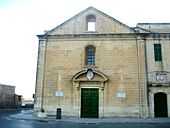Mediterranean Conference Centre
| Mediterranean Conference Centre | |
|---|---|
 | |
| Former names | Sacra Infermeria |
| Alternative names | MCC |
| General information | |
| Type | Convention center |
| Architectural style | Baroque |
| Location | Valletta, Malta |
| Construction started | 7th November 1574 |
| Technical details | |
| Floor area | 7,000 square metres |
| Website | |
| http://www.mcc.com.mt/ | |
The Mediterranean Conference Centre is a building situated near the tip, on the eastern side, of Valletta. The building was formerly a hospital and was previously known as the Holy Infirmary. Today it is a convention centre used for multiple banquets, exhibitions, international conventions and theatrical shows.
History
The Holy Infirmary was ordered to be built by Grandmaster Jean de la Cassière on the 7 November 1574, after a Chapter General, to replace the already existing one in Birgu. Construction instigated in the same year. It was completed towards the end of the 16th Century. It was meant to receive Maltese and foreign patients, as well as to provide lodging to pilgrims travelling to the Holy Land. It also had two pharmacies. In 1596 a phalange was built, which was meant to accommodate the patients suffering from venereal and contagious diseases. In 1636, one of the pharmacies was closed down. During the reign of Grand Master Raphael Cotoner, the infirmary was enlarged, having more wards added. This work continued until 1666, during the reign of Raphael’s successor and brother, Nicolas Cotoner. The ‘Old Ward’ was also extended. Also during his reign, in 1676, a School of Anatomy and Surgery was established in the infirmary itself. A dissection room was built in the infirmary due to the school, which was later on moved to the site of the graveyard outside the infirmary. More work was carried out in 1712, during the reign of Grandmaster Ramon Perellos y Roccaful. These included a Quadrangle, the Chapel of the Blessed Sacrament, a laboratory and a pharmacy.
When the French, under Napoleon Bonaparte, occupied Malta in 1798, they made alterations to the hospital. They improved its ventilation, sanitation and lighting. They also changed it to a military hospital to accommodate the sick French sailors and soldiers, which resulted in the name change from Sacra Infermeria to Hopital Militaire. As soon as the Maltese insurrection began, the hospital's efficiency began to deteriorate. Supplies like medication, fresh food, water and clothing were scarce. Diseases like nightblindness, scurvy, intestinal diseases and phthisiswere common. The French capitulated on 5 September 1800 and it was immediately occupied by 350 British Troops.
The new General Hospital now became a Station Hospital to accommodate the wounded British soldiers being brought in by Hospital ships. This was done due to its strategic position overlooking the harbour. This meant that the seriously injured troops could be easily and quickly transported there. The hospital saw much use mainly during the Napoleonic Wars, the Crimean War and the First World War. In effect by World War I Malta was known as the 'Nurse of the Mediterranean'. Between 1863 and 1865 more alterations were made to improve the building. In 1887, the Scottish microbiologist David Bruce and the Maltese doctor Giuseppe Caruana Scicluna discovered the germ Brucellosis in this building. The Station Hospital was brought to an end in 1918, by the conclusion of the Great War. From then up till May 1940 it served as the headquarters of the Malta police Force. It was evacuated during the Second World War during which it took four direct hits, which destroyed certain parts of it. After the War, the part of the 'Great Ward' which remained became a Command Hall for the Allied Troops. It remained so till 1950. Afterwards it became a Children's Theatre for a year. In 1959, the centre became a school and an examination centre. Restoration was attempted multiple times, however in 1978 a full restoration started and on 11 November 1979, the current centre was inaugurated. It was later awarded the Europa Nostra Diploma of Merit.